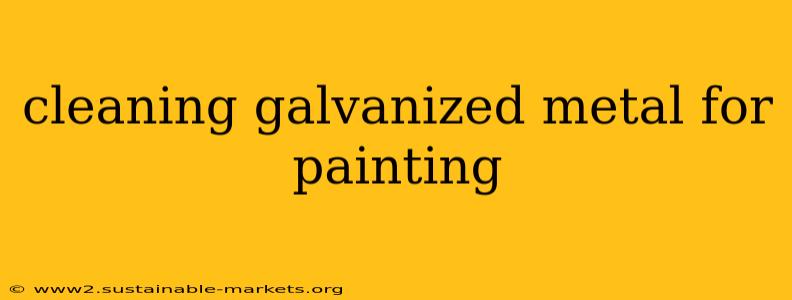Galvanized metal, with its protective zinc coating, is incredibly durable and versatile. However, before painting, proper cleaning is crucial for optimal adhesion and a long-lasting finish. This comprehensive guide will walk you through the process, ensuring your paint job looks great and lasts for years.
Why Clean Galvanized Metal Before Painting?
The zinc coating on galvanized steel reacts with the atmosphere, forming a layer of zinc carbonate. This layer, while protective, can prevent paint from adhering properly. Improper cleaning leads to peeling, chipping, and premature paint failure. Cleaning removes this layer, creating a surface ideal for paint bonding. This results in a much more durable and aesthetically pleasing finish.
Assessing Your Galvanized Metal Surface
Before you start cleaning, it's essential to assess the condition of your galvanized metal. Is it new, lightly weathered, or heavily rusted? The cleaning method will vary depending on the level of weathering.
1. New Galvanized Metal:
New galvanized metal requires minimal cleaning. A thorough cleaning with a degreaser and a wire brush is usually sufficient to remove any mill scale or light surface contaminants.
2. Lightly Weathered Galvanized Metal:
Lightly weathered galvanized metal may have some surface oxidation. In this case, a more thorough cleaning with a wire brush, followed by a degreaser and possibly a chemical cleaner, may be necessary.
3. Heavily Weathered or Rusted Galvanized Metal:
Heavily weathered or rusted galvanized metal requires more aggressive cleaning techniques. This may involve wire brushing, chemical cleaning, and possibly even sandblasting or media blasting (for very large or heavily corroded surfaces). Remember safety precautions—always wear appropriate personal protective equipment (PPE) when working with aggressive cleaning methods.
Cleaning Methods for Galvanized Metal
Several methods can effectively clean galvanized metal for painting. The best choice depends on the condition of the metal and your available resources.
1. Wire Brushing:
A wire brush, either manual or power-driven, is excellent for removing loose rust, mill scale, and surface contaminants. For power brushing, start with a coarser brush and then switch to a finer one to achieve a smoother finish. Always brush in the direction of the metal's grain to prevent scratching.
2. Chemical Cleaning:
Several chemical cleaners are specifically designed for galvanized metal. These cleaners typically dissolve the zinc carbonate layer, leaving a clean surface for painting. Always follow the manufacturer's instructions carefully and ensure adequate ventilation. Wear appropriate PPE, including gloves and eye protection.
3. Degreasing:
After mechanical cleaning, degreasing is essential to remove any grease, oil, or other contaminants. A suitable degreaser, such as mineral spirits or a commercial metal cleaner, should be applied and allowed to dwell according to the product instructions. Thoroughly rinse the surface with clean water before proceeding.
4. Power Washing (with caution):
High-pressure power washing can be effective for removing loose debris, but use caution. Excessive pressure can damage the galvanized coating, defeating the purpose of cleaning. Maintain a safe distance and use a lower pressure setting. Consider using a low-pressure washer with a suitable nozzle for delicate work.
5. Sandblasting or Media Blasting (for Professionals):
For severely corroded or heavily weathered galvanized metal, sandblasting or media blasting may be necessary. This is best left to professionals due to the specialized equipment and safety precautions involved.
Preparing for Painting
Once the galvanized metal is thoroughly cleaned, allow it to dry completely before painting. Applying a zinc-rich primer is highly recommended to provide additional corrosion protection and enhance paint adhesion. After the primer has dried, you can apply your chosen topcoat.
Conclusion
Cleaning galvanized metal before painting is essential for a long-lasting and aesthetically pleasing finish. By following this comprehensive guide and choosing the appropriate cleaning method, you'll ensure your paint job adheres properly and protects your galvanized metal for years to come. Remember safety first and always use appropriate PPE when handling cleaning chemicals or power tools.

